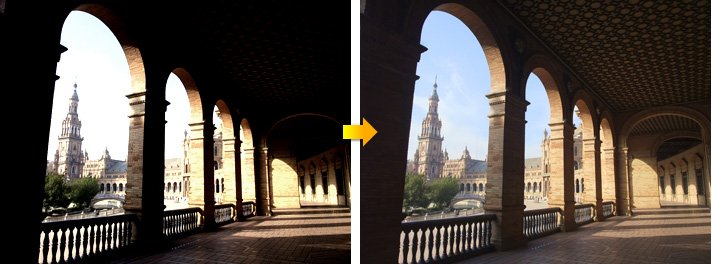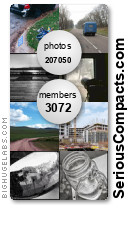Announced last year, the Super CCD EXR sensor in the new Fuji F200EXR allows the photographer to choose between three different implementations depending on the shot: 1) All 12 million pixels can be applied in the usual manner for maximum resolution; 2) Pixel binning can be applied to combine pixel pairs for improved sensitivity and low noise; or 3) Half the pixels can be used to capture an image of one exposure and the other half a different exposure; the two exposures are then combined in camera to produce an image with wide dynamic range (a similar approach to that employed in the Fuji S3 and S5 DSLRs).
While the maximum resolution and high sensitivity configurations don't represent a radical change from what is offered in other cameras, the wide dynamic range mode addresses a major shortcoming of small sensor cameras. The following example from the Fuji site shows the effects of the application of this mode:
Until now, the only way to get a truly wide dynamic range in a camera was to go with a large sensor. Yet, as Sigma has found with the DP1, the only way to get a large sensor in a compact camera is to limit lens speed and zoom range.
Unlike a large sensor, the 1/1.6" Super CCD EXR sensor cannot simultaneously yield high sensitivity and wide dynamic range. In fact, unsurprisingly, early samples of the high sensitivity mode aren't earth shattering. There's no way to collect a ton of light on a small surface. However, if this little sensor can deliver Fuji's claimed dynamic range, it could go a long way towards improving small sensor image quality.
Now please, Fuji, take this sensor and put it in a larger (but not too large) camera with a faster lens, RAW, and intuitive dials to control ISO, aperture, and exposure compensation!
Go to 1001 Noisy Cameras for full coverage of the new Fuji F200EXR.
Fuji F200 EXR Wide Dynamic Range
Thursday, February 5, 2009
Fuji F200 EXR Wide Dynamic Range
2009-02-05T08:25:00-05:00
Amin
Subscribe to:
Post Comments (Atom)

